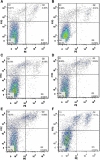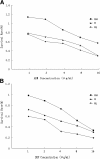Blockade of PI3K/AKT pathway enhances sensitivity of Raji cells to chemotherapy through down-regulation of HSP70
- PMID: 23706027
- PMCID: PMC3680239
- DOI: 10.1186/1475-2867-13-48
Blockade of PI3K/AKT pathway enhances sensitivity of Raji cells to chemotherapy through down-regulation of HSP70
Abstract
Up-regulation of heat shock protein 70 (HSP70) could be elicited primarily by heat in former studies, and this was proved to be associated with cancer progression. Burkitt's lymphoma is one of highly aggressive B-cell non-Hodgkin's lymphoma and is one of the fastest growing human tumors. To investigate the effect of HSP70 expression on the sensitivity of human Burkitt lymphoma cells (Raji cells) to chemotherapy and its role in the involvement of PI3K/AKT pathway, we evaluated the effects of LY294002, a PI3K inhibitor, on the expression of HSP70 and cell sensitivity to adriamycin (ADM) or cisplatin (DDP). In present study, expressions of HSP70, AKT and phosphorylated AKT (p-AKT) in Raji cells were measured by Western-Blot. Apoptosis index of Raji cells was examined by flow cytometry. Cytotoxicities of adriamycin (ADM) and cisplatin (DDP) were determined by WST-8 assay. We found that hyperthermia (42 degrees for 1 hour) up-regulated the expression of HSP70 expression and blockade of PI3K/AKT pathway down-regulated HSP70 expression in Raji cells. Compared to cells treated with ADM or DDP alone, hyperthermia protected cells from chemotherapy while LY294002 enhanced sensitivity of Raji cells to chemotherapy. Our results suggested down-regulation of HSP70 expression by blockade of PI3K/AKT pathway maybe responsible for the increased sensitivity of Raji cells to chemotherapy. Targeting PI3K/AKT pathway or inhibiting HSP70 expression may be beneficial for chemotherapy treatment of Burkitt lymphoma patients.
Figures



Similar articles
-
Inhibition of JAK2/STAT3 Signaling Pathway Suppresses Proliferation of Burkitt's Lymphoma Raji Cells via Cell Cycle Progression, Apoptosis, and Oxidative Stress by Modulating HSP70.Med Sci Monit. 2018 Sep 8;24:6255-6263. doi: 10.12659/MSM.910170. Med Sci Monit. 2018. PMID: 30194286 Free PMC article.
-
Inhibition of the PI3K/AKT-NF-κB pathway with curcumin enhanced radiation-induced apoptosis in human Burkitt's lymphoma.J Pharmacol Sci. 2013;121(4):247-56. doi: 10.1254/jphs.12149fp. J Pharmacol Sci. 2013. PMID: 23603894
-
Downregulation of microRNA-4295 enhances cisplatin-induced gastric cancer cell apoptosis through the EGFR/PI3K/Akt signaling pathway by targeting LRIG1.Int J Oncol. 2018 Dec;53(6):2566-2578. doi: 10.3892/ijo.2018.4595. Epub 2018 Oct 12. Int J Oncol. 2018. PMID: 30320337 Free PMC article.
-
Silencing long non-coding RNA ROR improves sensitivity of non-small-cell lung cancer to cisplatin resistance by inhibiting PI3K/Akt/mTOR signaling pathway.Tumour Biol. 2017 May;39(5):1010428317697568. doi: 10.1177/1010428317697568. Tumour Biol. 2017. PMID: 28459375
-
PRINCIPLES OF PI3K BIOLOGY AND ITS ROLE IN LYMPHOMA.In: O'Conner OA, Ansell SM, Seymour JF, editors. Targeting Oncogenic Drivers and Signaling Pathways in Hematologic Malignancies: From Concept to Practice [Internet]. Hoboken (NJ): Wiley-Blackwell; 2023. In: O'Conner OA, Ansell SM, Seymour JF, editors. Targeting Oncogenic Drivers and Signaling Pathways in Hematologic Malignancies: From Concept to Practice [Internet]. Hoboken (NJ): Wiley-Blackwell; 2023. PMID: 36282940 Free Books & Documents. Review.
Cited by
-
The increased expression of the inducible Hsp70 (HSP70A1A) in serum of patients with heart failure and its protective effect against the cardiotoxic agent doxorubicin.Mol Cell Biochem. 2019 May;455(1-2):41-59. doi: 10.1007/s11010-018-3469-7. Epub 2018 Nov 2. Mol Cell Biochem. 2019. PMID: 30390173
-
Nuclear heat shock protein 110 expression is associated with poor prognosis and hyperthermo-chemotherapy resistance in gastric cancer patients with peritoneal metastasis.World J Gastroenterol. 2017 Nov 14;23(42):7541-7550. doi: 10.3748/wjg.v23.i42.7541. World J Gastroenterol. 2017. PMID: 29204054 Free PMC article.
-
Salidroside inhibits the proliferation and migration of gastric cancer cells via suppression of Src‑associated signaling pathway activation and heat shock protein 70 expression.Mol Med Rep. 2018 Jul;18(1):147-156. doi: 10.3892/mmr.2018.8958. Epub 2018 May 3. Mol Med Rep. 2018. PMID: 29749547 Free PMC article.
-
Fisetin targets phosphatidylinositol-3-kinase and induces apoptosis of human B lymphoma Raji cells.Toxicol Rep. 2015 Jul 13;2:984-989. doi: 10.1016/j.toxrep.2015.07.004. eCollection 2015. Toxicol Rep. 2015. PMID: 28962438 Free PMC article.
-
Inhibition of JAK2/STAT3 Signaling Pathway Suppresses Proliferation of Burkitt's Lymphoma Raji Cells via Cell Cycle Progression, Apoptosis, and Oxidative Stress by Modulating HSP70.Med Sci Monit. 2018 Sep 8;24:6255-6263. doi: 10.12659/MSM.910170. Med Sci Monit. 2018. PMID: 30194286 Free PMC article.
References
-
- Schmitz R, Young RM, Ceribelli M, Jhavar S, Xiao W, Zhang M, Wright G, Shaffer AL, Hodson DJ, Buras E, Liu X, Powell J, Yang Y, Xu W, Zhao H, Kohlhammer H, Rosenwald A, Kluin P, Müller-Hermelink HK, Ott G, Gascoyne RD, Connors JM, Rimsza LM, Campo E, Jaffe ES, Delabie J, Smeland EB, Ogwang MD, Reynolds SJ, Fisher RI. Burkitt lymphoma pathogenesis and therapeutic targets from structural and functional genomics. Nature. 2012;490:116–120. doi: 10.1038/nature11378. - DOI - PMC - PubMed
LinkOut - more resources
Full Text Sources
Other Literature Sources

